steering CHRYSLER SEBRING CONVERTIBLE 2004 2.G Owner's Manual
[x] Cancel search | Manufacturer: CHRYSLER, Model Year: 2004, Model line: SEBRING CONVERTIBLE, Model: CHRYSLER SEBRING CONVERTIBLE 2004 2.GPages: 271, PDF Size: 5.31 MB
Page 187 of 271
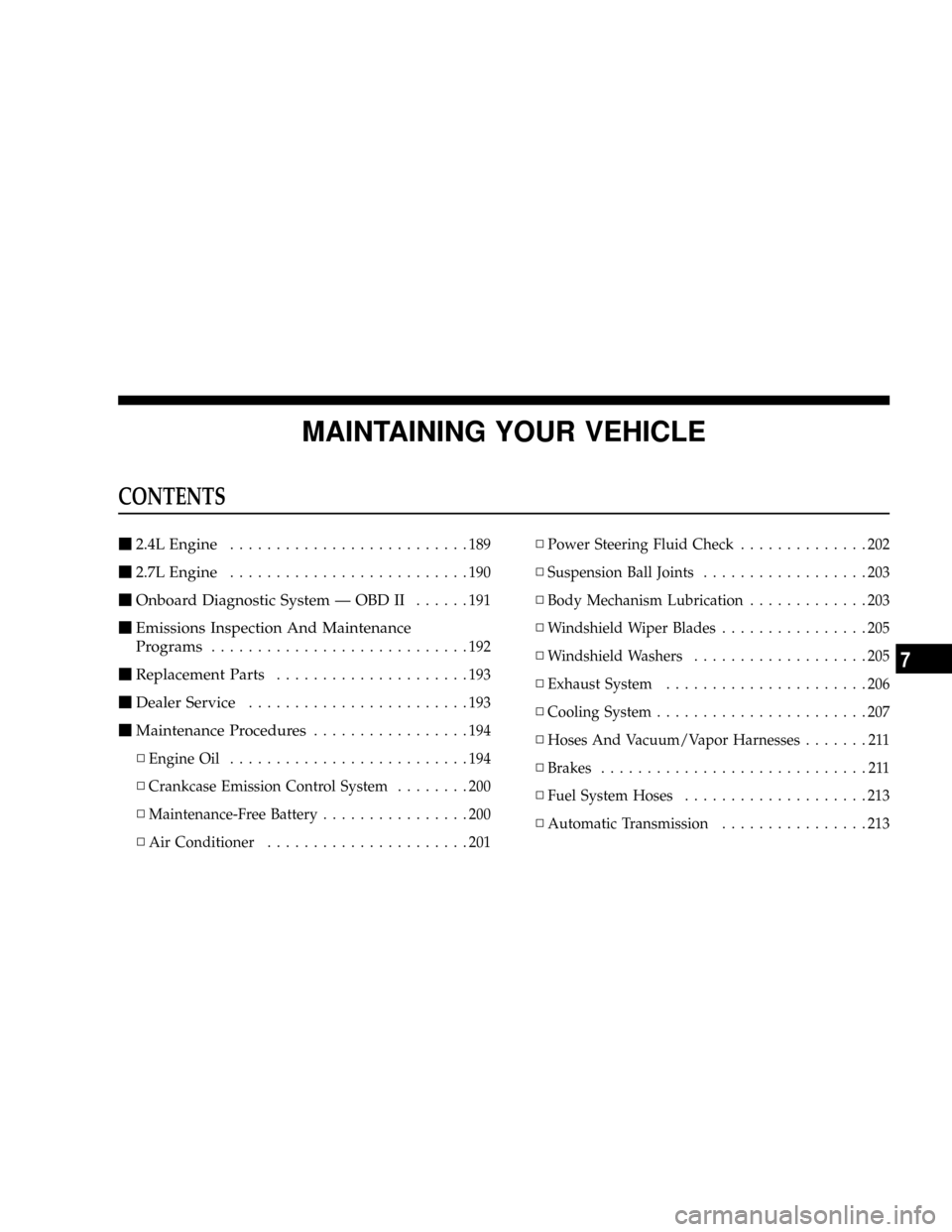
MAINTAINING YOUR VEHICLE
CONTENTS
m2.4L Engine..........................189
m2.7L Engine..........................190
mOnboard Diagnostic System Ð OBD II......191
mEmissions Inspection And Maintenance
Programs
............................192
mReplacement Parts.....................193
mDealer Service........................193
mMaintenance Procedures.................194
NEngine Oil..........................194
NCrankcase Emission Control System........200
NMaintenance-Free Battery................200
NAir Conditioner......................201NPower Steering Fluid Check..............202
NSuspension Ball Joints..................203
NBody Mechanism Lubrication.............203
NWindshield Wiper Blades................205
NWindshield Washers...................205
NExhaust System......................206
NCooling System.......................207
NHoses And Vacuum/Vapor Harnesses.......211
NBrakes.............................211
NFuel System Hoses....................213
NAutomatic Transmission................213
7
Page 200 of 271

²Do not idle the engine with any spark plug wires
disconnected for prolonged period.
Engine Timing Belt
Replace the engine timing belt (2.4L Only) at the intervals
described in the appropriate maintenance schedule.
Crankcase Emission Control System
Proper operation of this system depends on freedom
from sticking or plugging due to deposits. As vehicle
mileage builds up, the Positive Crankshaft Ventilation
(PCV) valve and passages may accumulate deposits. If a
valve is not working properly, replace it with a new
valve. DO NOT ATTEMPT TO CLEAN THE OLD PCV
VALVE!
Check ventilation hose for indication of damage or
plugging deposits. Replace if necessary.
Maintenance-Free Battery
The top of the MAINTENANCE-FREE battery is perma-
nently sealed. You will never have to add water, nor is
periodic maintenance required.
NOTE:The battery is stored in a compartment behind
the left front fender and is accessible without removing
the tire and wheel. Remote battery terminals are located
in the engine compartment for jump starting.
To access the battery, turn the steering wheel fully to the
right and remove the inner fender shield.
200 MAINTAINING YOUR VEHICLE
Page 202 of 271
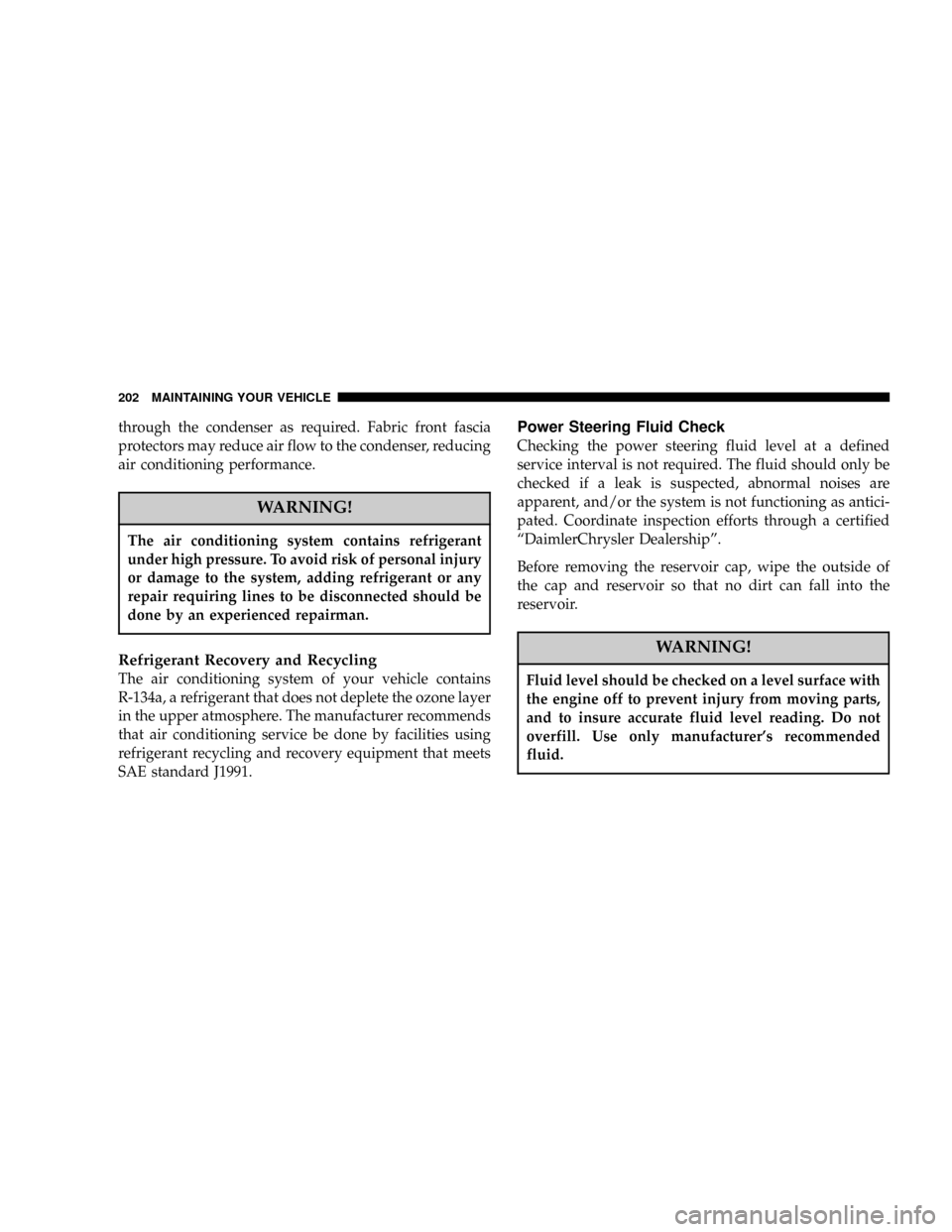
through the condenser as required. Fabric front fascia
protectors may reduce air flow to the condenser, reducing
air conditioning performance.
WARNING!
The air conditioning system contains refrigerant
under high pressure. To avoid risk of personal injury
or damage to the system, adding refrigerant or any
repair requiring lines to be disconnected should be
done by an experienced repairman.
Refrigerant Recovery and Recycling
The air conditioning system of your vehicle contains
R-134a, a refrigerant that does not deplete the ozone layer
in the upper atmosphere. The manufacturer recommends
that air conditioning service be done by facilities using
refrigerant recycling and recovery equipment that meets
SAE standard J1991.
Power Steering Fluid Check
Checking the power steering fluid level at a defined
service interval is not required. The fluid should only be
checked if a leak is suspected, abnormal noises are
apparent, and/or the system is not functioning as antici-
pated. Coordinate inspection efforts through a certified
ªDaimlerChrysler Dealershipº.
Before removing the reservoir cap, wipe the outside of
the cap and reservoir so that no dirt can fall into the
reservoir.
WARNING!
Fluid level should be checked on a level surface with
the engine off to prevent injury from moving parts,
and to insure accurate fluid level reading. Do not
overfill. Use only manufacturer's recommended
fluid.
202 MAINTAINING YOUR VEHICLE
Page 211 of 271
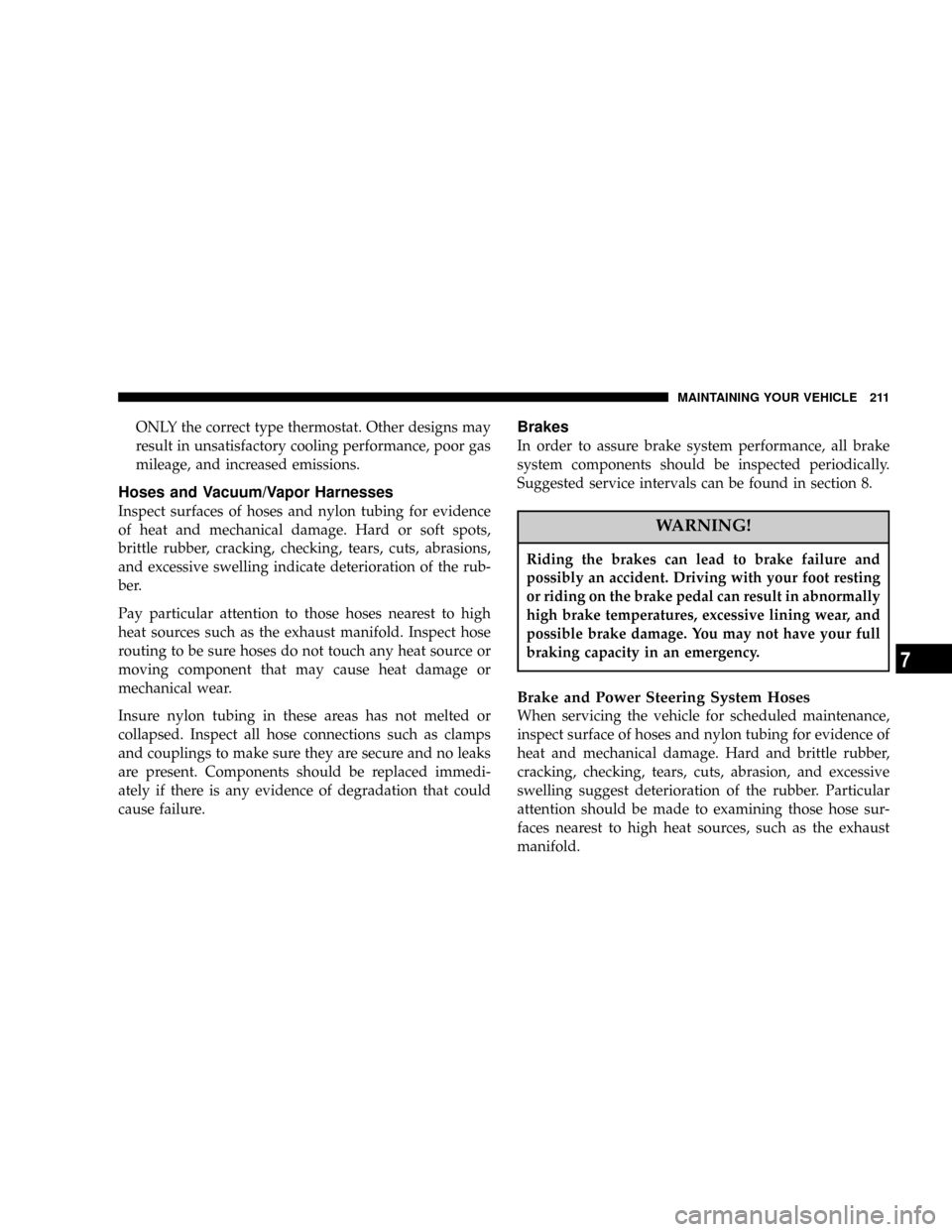
ONLY the correct type thermostat. Other designs may
result in unsatisfactory cooling performance, poor gas
mileage, and increased emissions.
Hoses and Vacuum/Vapor Harnesses
Inspect surfaces of hoses and nylon tubing for evidence
of heat and mechanical damage. Hard or soft spots,
brittle rubber, cracking, checking, tears, cuts, abrasions,
and excessive swelling indicate deterioration of the rub-
ber.
Pay particular attention to those hoses nearest to high
heat sources such as the exhaust manifold. Inspect hose
routing to be sure hoses do not touch any heat source or
moving component that may cause heat damage or
mechanical wear.
Insure nylon tubing in these areas has not melted or
collapsed. Inspect all hose connections such as clamps
and couplings to make sure they are secure and no leaks
are present. Components should be replaced immedi-
ately if there is any evidence of degradation that could
cause failure.
Brakes
In order to assure brake system performance, all brake
system components should be inspected periodically.
Suggested service intervals can be found in section 8.
WARNING!
Riding the brakes can lead to brake failure and
possibly an accident. Driving with your foot resting
or riding on the brake pedal can result in abnormally
high brake temperatures, excessive lining wear, and
possible brake damage. You may not have your full
braking capacity in an emergency.
Brake and Power Steering System Hoses
When servicing the vehicle for scheduled maintenance,
inspect surface of hoses and nylon tubing for evidence of
heat and mechanical damage. Hard and brittle rubber,
cracking, checking, tears, cuts, abrasion, and excessive
swelling suggest deterioration of the rubber. Particular
attention should be made to examining those hose sur-
faces nearest to high heat sources, such as the exhaust
manifold.
MAINTAINING YOUR VEHICLE 211
7
Page 212 of 271
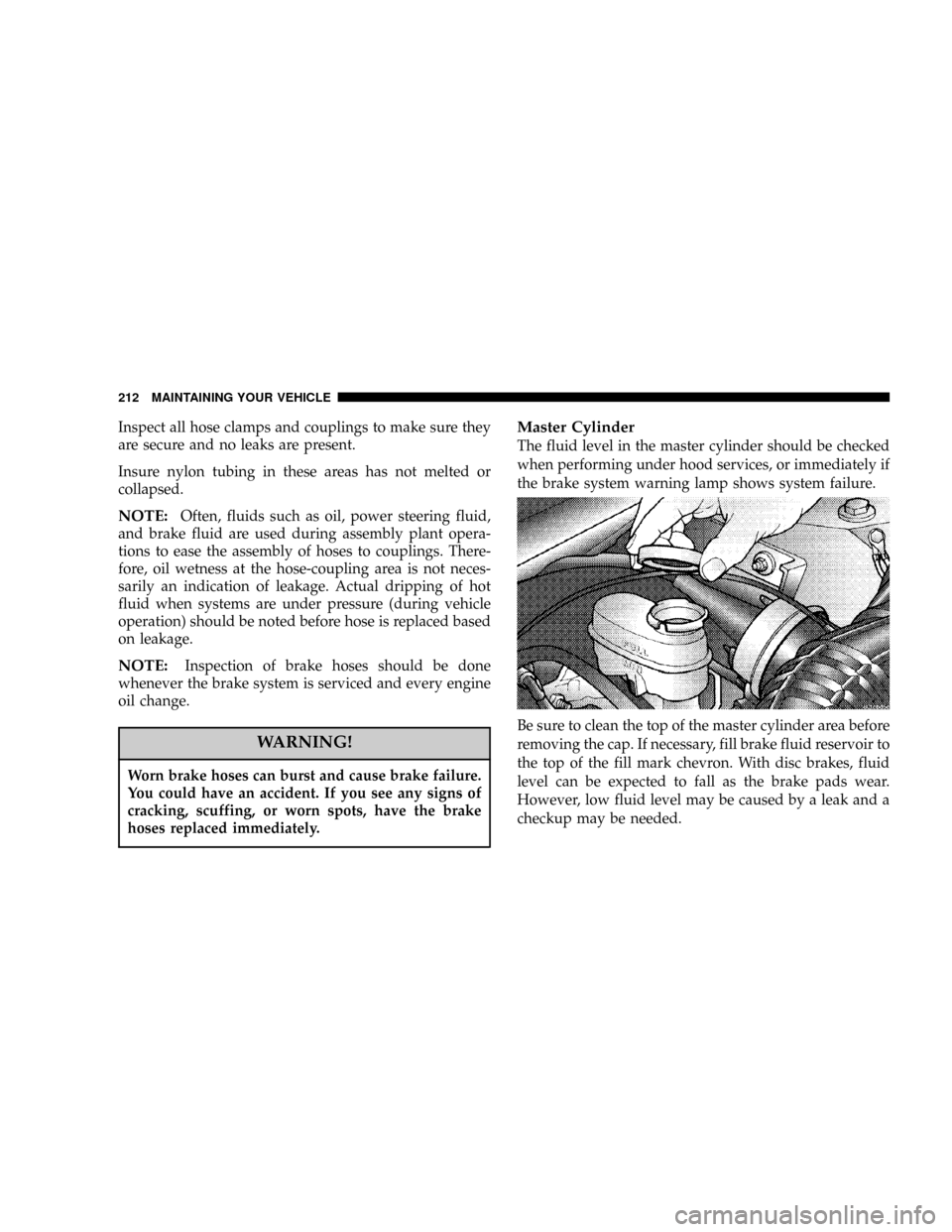
Inspect all hose clamps and couplings to make sure they
are secure and no leaks are present.
Insure nylon tubing in these areas has not melted or
collapsed.
NOTE:Often, fluids such as oil, power steering fluid,
and brake fluid are used during assembly plant opera-
tions to ease the assembly of hoses to couplings. There-
fore, oil wetness at the hose-coupling area is not neces-
sarily an indication of leakage. Actual dripping of hot
fluid when systems are under pressure (during vehicle
operation) should be noted before hose is replaced based
on leakage.
NOTE:Inspection of brake hoses should be done
whenever the brake system is serviced and every engine
oil change.
WARNING!
Worn brake hoses can burst and cause brake failure.
You could have an accident. If you see any signs of
cracking, scuffing, or worn spots, have the brake
hoses replaced immediately.
Master Cylinder
The fluid level in the master cylinder should be checked
when performing under hood services, or immediately if
the brake system warning lamp shows system failure.
Be sure to clean the top of the master cylinder area before
removing the cap. If necessary, fill brake fluid reservoir to
the top of the fill mark chevron. With disc brakes, fluid
level can be expected to fall as the brake pads wear.
However, low fluid level may be caused by a leak and a
checkup may be needed.
212 MAINTAINING YOUR VEHICLE
Page 233 of 271
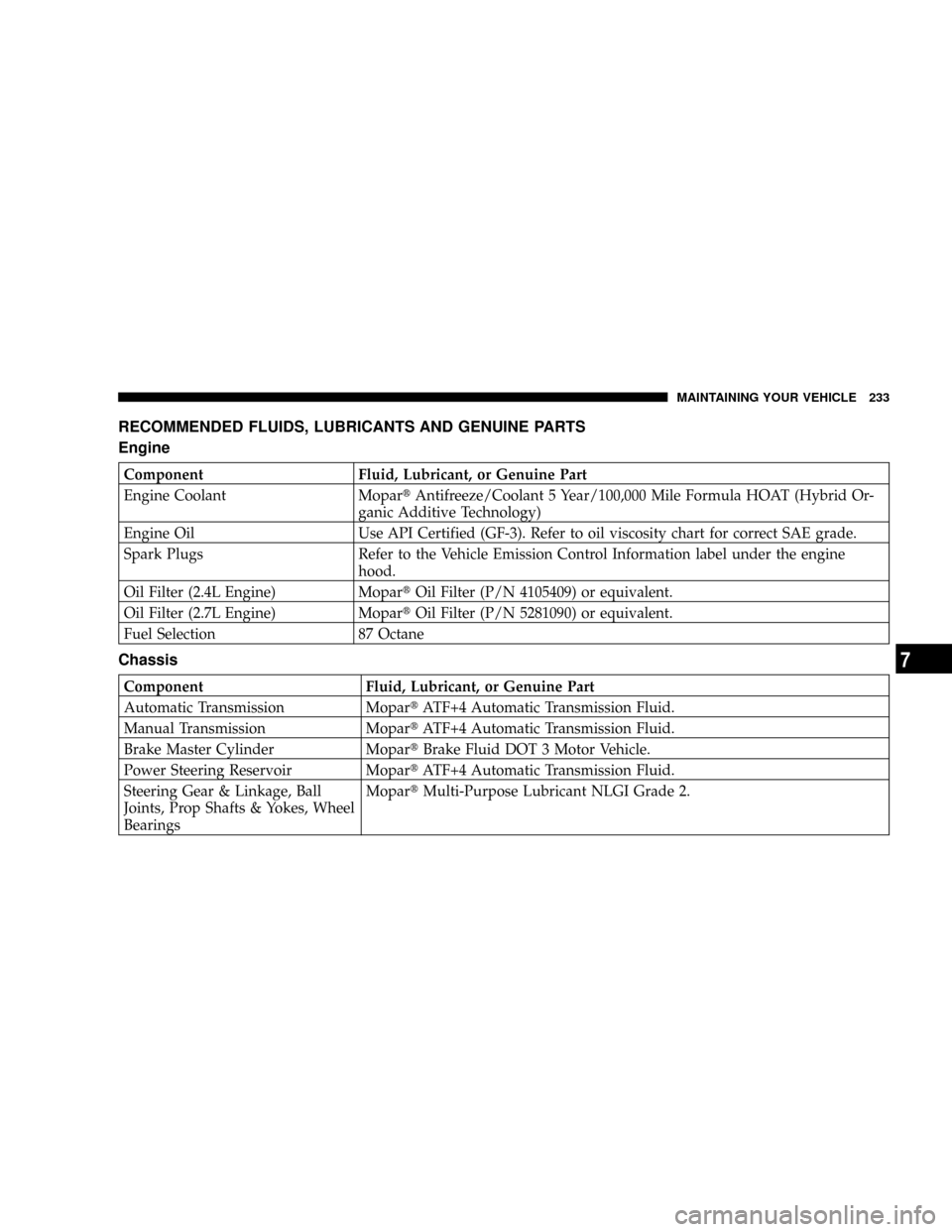
RECOMMENDED FLUIDS, LUBRICANTS AND GENUINE PARTS
Engine
Component Fluid, Lubricant, or Genuine Part
Engine Coolant MopartAntifreeze/Coolant 5 Year/100,000 Mile Formula HOAT (Hybrid Or-
ganic Additive Technology)
Engine Oil Use API Certified (GF-3). Refer to oil viscosity chart for correct SAE grade.
Spark Plugs Refer to the Vehicle Emission Control Information label under the engine
hood.
Oil Filter (2.4L Engine) MopartOil Filter (P/N 4105409) or equivalent.
Oil Filter (2.7L Engine) MopartOil Filter (P/N 5281090) or equivalent.
Fuel Selection 87 Octane
Chassis
Component Fluid, Lubricant, or Genuine Part
Automatic Transmission MopartATF+4 Automatic Transmission Fluid.
Manual Transmission MopartATF+4 Automatic Transmission Fluid.
Brake Master Cylinder MopartBrake Fluid DOT 3 Motor Vehicle.
Power Steering Reservoir MopartATF+4 Automatic Transmission Fluid.
Steering Gear & Linkage, Ball
Joints, Prop Shafts & Yokes, Wheel
BearingsMopartMulti-Purpose Lubricant NLGI Grade 2.
MAINTAINING YOUR VEHICLE 233
7
Page 241 of 271
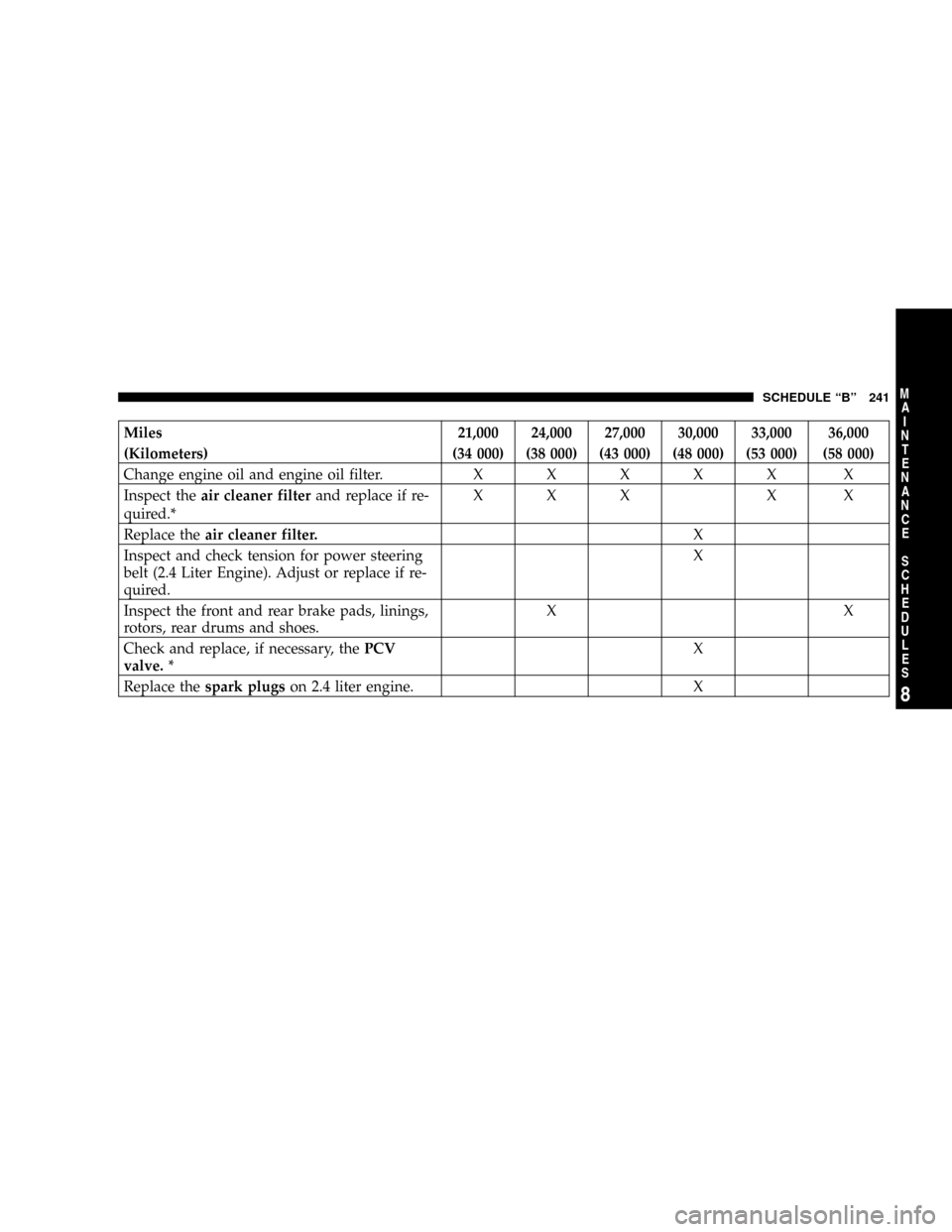
Miles 21,000 24,000 27,000 30,000 33,000 36,000
(Kilometers) (34 000) (38 000) (43 000) (48 000) (53 000) (58 000)
Change engine oil and engine oil filter.XXXXX X
Inspect theair cleaner filterand replace if re-
quired.*XXX X X
Replace theair cleaner filter.X
Inspect and check tension for power steering
belt (2.4 Liter Engine). Adjust or replace if re-
quired.X
Inspect the front and rear brake pads, linings,
rotors, rear drums and shoes.XX
Check and replace, if necessary, thePCV
valve.*X
Replace thespark plugson 2.4 liter engine. X
SCHEDULE ªBº 241
8
M
A
I
N
T
E
N
A
N
C
E
S
C
H
E
D
U
L
E
S
Page 243 of 271
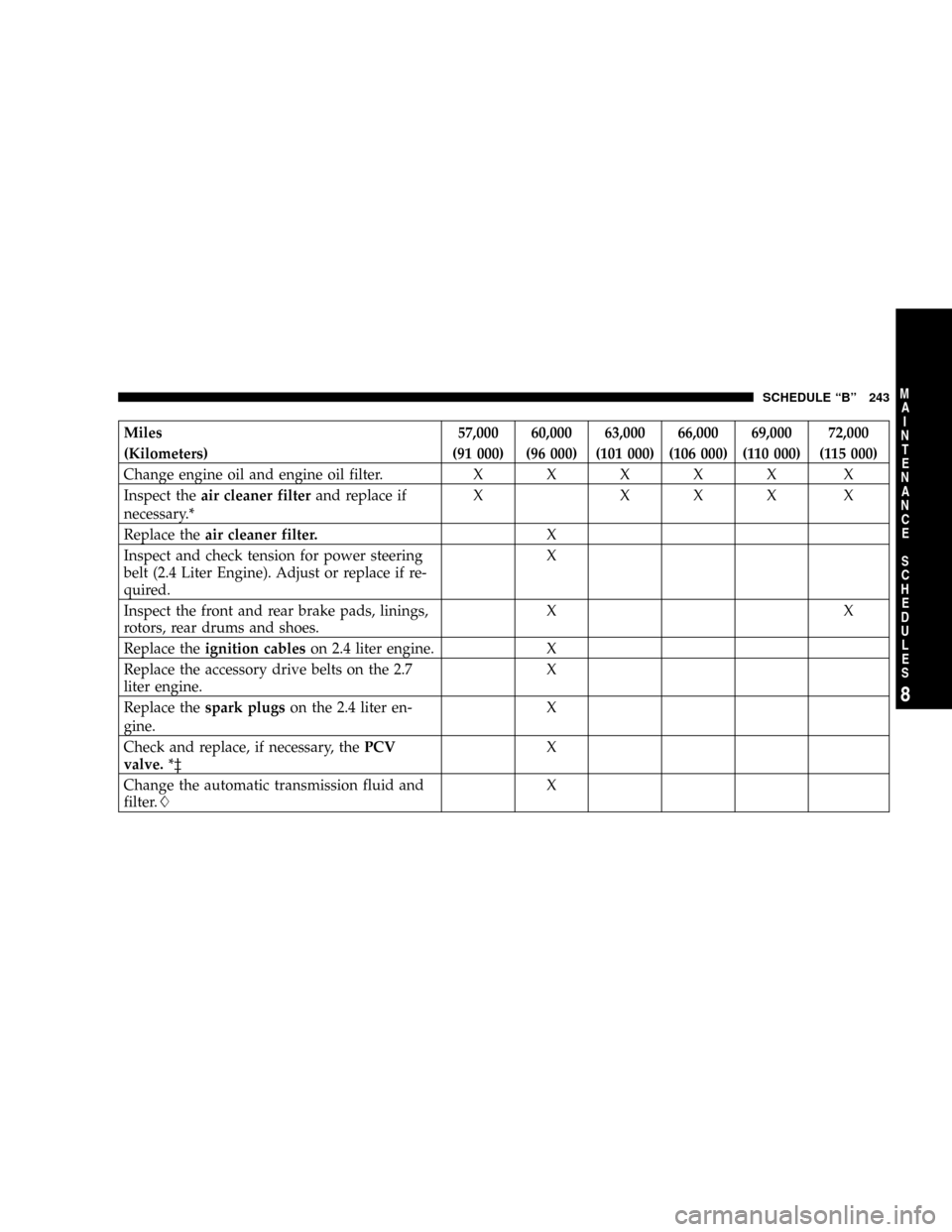
Miles 57,000 60,000 63,000 66,000 69,000 72,000
(Kilometers) (91 000) (96 000) (101 000) (106 000) (110 000) (115 000)
Change engine oil and engine oil filter.XXXXX X
Inspect theair cleaner filterand replace if
necessary.*X XXX X
Replace theair cleaner filter.X
Inspect and check tension for power steering
belt (2.4 Liter Engine). Adjust or replace if re-
quired.X
Inspect the front and rear brake pads, linings,
rotors, rear drums and shoes.XX
Replace theignition cableson 2.4 liter engine. X
Replace the accessory drive belts on the 2.7
liter engine.X
Replace thespark plugson the 2.4 liter en-
gine.X
Check and replace, if necessary, thePCV
valve.*³X
Change the automatic transmission fluid and
filter.LX
SCHEDULE ªBº 243
8
M
A
I
N
T
E
N
A
N
C
E
S
C
H
E
D
U
L
E
S
Page 244 of 271
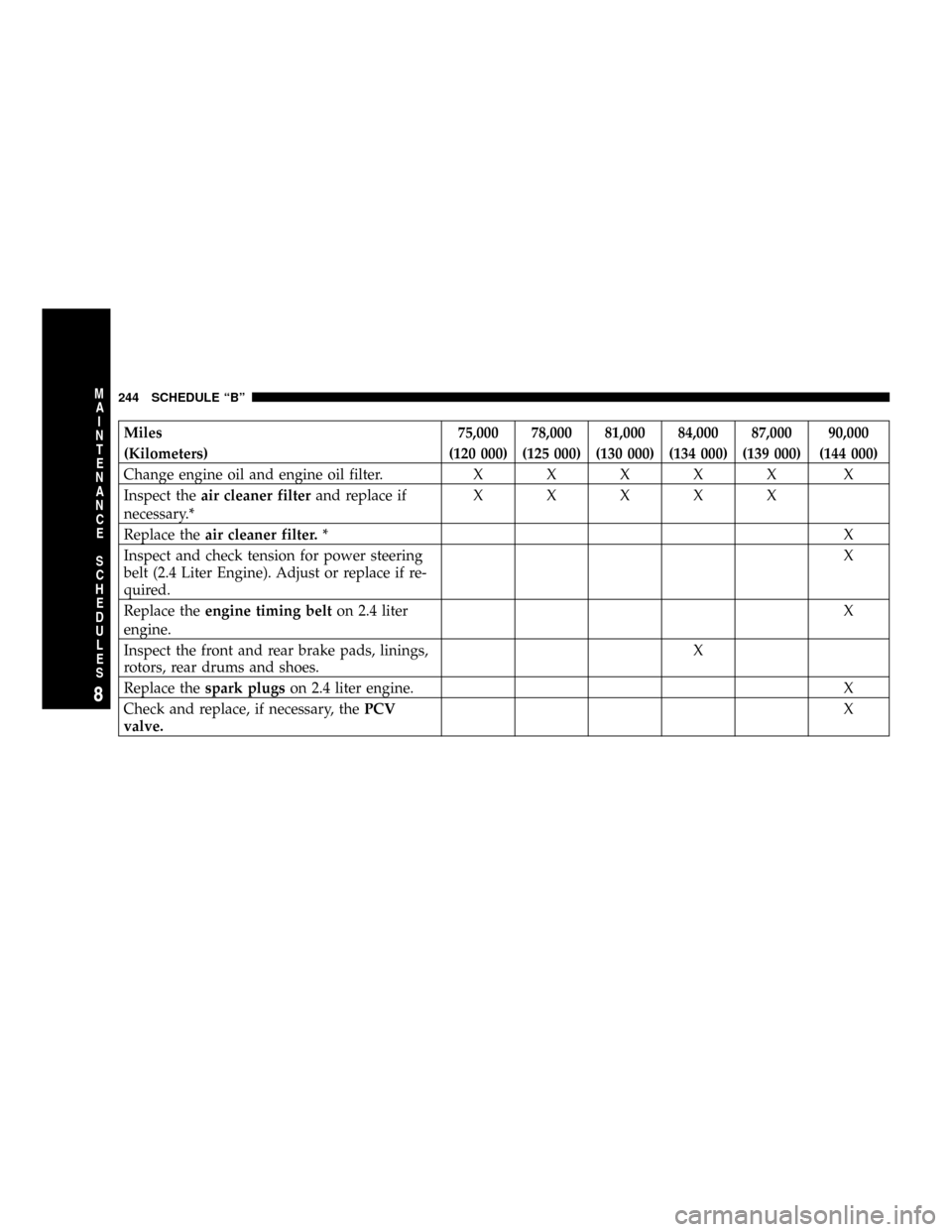
Miles 75,000 78,000 81,000 84,000 87,000 90,000
(Kilometers) (120 000) (125 000) (130 000) (134 000) (139 000) (144 000)
Change engine oil and engine oil filter.XXXXX X
Inspect theair cleaner filterand replace if
necessary.*XXXXX
Replace theair cleaner filter.*X
Inspect and check tension for power steering
belt (2.4 Liter Engine). Adjust or replace if re-
quired.X
Replace theengine timing belton 2.4 liter
engine.X
Inspect the front and rear brake pads, linings,
rotors, rear drums and shoes.X
Replace thespark plugson 2.4 liter engine. X
Check and replace, if necessary, thePCV
valve.X
244 SCHEDULE ªBº
8
M
A
I
N
T
E
N
A
N
C
E
S
C
H
E
D
U
L
E
S
Page 247 of 271
![CHRYSLER SEBRING CONVERTIBLE 2004 2.G Owners Manual Miles 42,000 48,000 54,000 60,000 66,000 72,000
(Kilometers) (67 000) (77 000) (86 000) (96 000) (106 000) (115 000)
[Months] [42] [48] [54] [60] [66] [72]
Change engine oil and engine oil filter. X X CHRYSLER SEBRING CONVERTIBLE 2004 2.G Owners Manual Miles 42,000 48,000 54,000 60,000 66,000 72,000
(Kilometers) (67 000) (77 000) (86 000) (96 000) (106 000) (115 000)
[Months] [42] [48] [54] [60] [66] [72]
Change engine oil and engine oil filter. X X](/img/25/8538/w960_8538-246.png)
Miles 42,000 48,000 54,000 60,000 66,000 72,000
(Kilometers) (67 000) (77 000) (86 000) (96 000) (106 000) (115 000)
[Months] [42] [48] [54] [60] [66] [72]
Change engine oil and engine oil filter. X XXXXX
Inspect theair cleaner filterand replace if
required.*XXX XX
Replace theair cleaner filter.*X
Inspect and check tension for power steering
belt (2.4 Liter Engine). Adjust or replace if re-
quired.X
Inspect the front and rear brake pads, linings,
rotors, rear drums and shoes.XX
Replace thespark plugson 2.4 liter engine. X
Flush and replace engine coolant at 60 months
or 100,000 miles.X
Check and replace, if necessary, thePCV
valve.*³X
Replace theignition cableson 2.4 liter en-
gine.X
Replace the accessory drive belts in 2.7 liter
engine.X
SCHEDULE ªAº 247
8
M
A
I
N
T
E
N
A
N
C
E
S
C
H
E
D
U
L
E
S